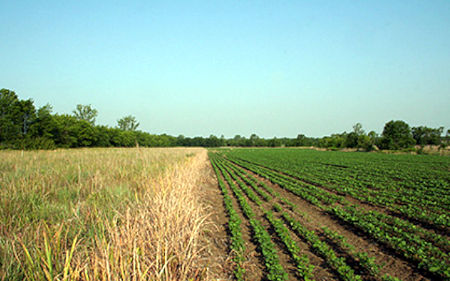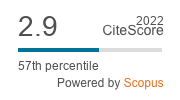Agricultural Set-aside Programs and Grassland Birds: Insights from Broad-scale Population Trend
DOI:
https://doi.org/10.3097/LO.200808Keywords:
Agricultural landscapes, Conservation reserve program, Farm bill, Grassland birds, Set-aside, USAAbstract
The Conservation Reserve Program (CRP) is a voluntary set-aside program in the United States designed to ameliorate soil erosion, control crop overproduction, enhance water quality, and provide wildlife habitat by replacing crops with other forms of land cover. Because CRP includes primarily grass habitats, it has great potential to benefit declining North American grassland bird populations. We looked at the change in national and state population trends of grassland birds and related changes to cover-specific CRP variables (previous research grouped all CRP practices). Changes in national trends after the initiation of the CRP were inconclusive, but we observed signficant bird-CRP relations at the state level. Most bird-CRP relations were positive, except for some species associated with habitats that CRP replaced. Practice- and configuration-specific CRP variables were related to grassland bird trends, rather than a generic measure of all CRP types combined. Considering all CRP land as a single, distinct habitat type may obscure actual relations between birds and set-aside characteristics. Understanding and predicting the effects of set-aside programs (like CRP or agri-environment schemes) on grassland birds is complex and difficult. Because available broad-scale datasets are less than adequate, studies should be conducted at a variety of spatial and temporal scales.
References
Arnqvist, G., & Wooster, D. (1995). Meta-analysis: Synthesizing research findings in ecology and evolution. Trends in Ecology & Evolution, 10(6), 236-240. doi:10.1016/S0169-5347(00)89073-4
Best, L. B. (2000). The value of buffer habitats for birds in agricultural landscapes. A Comprehensive Review of Farm Bill Contributions to Wildlife Conservation, 1985-2000, , 75-94.
Best, L. B., Campa III, H., Kemp, K. E., Robel, R. J., Ryan, M. R., Savidge, J. A., . . . Winterstein, S. R. (1997). Bird abundance and nesting in CRP fields and cropland in the midwest: A regional approach. Wildlife Society Bulletin, 25(4), 864-877.
Best, L. B., Freemark, K. E., Dinsmore, J. J., & Camp, M. (1995). A review and synthesis of habitat use by breeding birds in agricultural landscapes of iowa. American Midland Naturalist, 134(1), 1-29. doi:10.2307/2426479
Bock, C. E., Bock, J. H., & Bennett, B. C. (1999). Songbird abundance in grasslands at a suburban interface on the colorado high plains
Bracken, F., & Bolger, T. (2006). Effects of set-aside management on birds breeding in lowland ireland. Agriculture, Ecosystems and Environment, 117(2-3), 178-184. doi:10.1016/j.agee.2006.03.032
Brennan, L. A., & Kuvlesky Jr., W. P. (2005). North american grassland birds: An unfolding conservation crisis? Journal of Wildlife Management, 69(1), 1-13. doi:10.2193/0022-541X(2005)069<0001:NAGBAU>2.0.CO;2
Burger Jr., L. W. (2000). Wildlife response to the conservation reserve program in the southeast. A Comprehensive Review of Farm Bill Contributions to Wildlife Conservation 1985-2000, , 55-74.
Burger Jr., L. W., Kurzejeski, E. W., Dailey, T. V., & Ryan, M. R. (1990). Structural characteristics of vegetation in CRP fields in northern missouri and their suitability as bobwhite habitat. Transactions of the North American Wildlife and Natural Resources Conference, 55, 74-83.
Coppedge, B. R., Engle, D. M., Masters, R. E., & Gregory, M. S. (2001). Avian response to landscape change in fragmented southern great plains grasslands. Ecological Applications, 11(1), 47-59. doi:10.1890/1051-0761(2001)011[0047:ARTLCI]2.0.CO;2
Delisle, J. M., & Savidge, J. A. (1997). Avian use and vegetation characteristics of conservation reserve program fields. Journal of Wildlife Management, 61(2), 318-325. doi:10.2307/3802587
Greenfield, K. C., Chamberlain, M. J., Burger Jr., L. W., & Kurzejeski, E. W. (2003). Effects of burning and discing conservation reserve program fields to improve habitat quality for northern bobwhite (colinus virginianus). American Midland Naturalist, 149(2), 344-353. doi:10.1674/0003-0031(2003)149[0344:EOBADC]2.0.CO;2
Haufler, J. B. (2005). Fish and Wildlife Benefits of Farm Bill Conservation Programs: 2000-2005 Update,
Henderson, I. G., Cooper, J., Fuller, R. J., & Vickery, J. (2000). The relative abundance of birds on set-aside and neighbouring fields in summer. Journal of Applied Ecology, 37(2), 335-347. doi:10.1046/j.1365-2664.2000.00497.x
Herkert, J. R. (1997). Bobolink dolichonyx oryzivorus population decline in agricultural landscapes in the midwestern USA. Biological Conservation, 80(1), 107-112. doi:10.1016/S0006-3207(96)00066-3
Herkert, J. R. (1994). The effects of habitat fragmentation on midwestern grassland bird communities. Ecological Applications, 4(3), 461-471. doi:10.2307/1941950
Herkert, J. R. (1998). The influence of the CRP on grasshopper sparrow population trends in the mid-continental united states. Wildlife Society Bulletin, 26(2), 227-231.
Herkert, J. R., Reinking, D. L., Wiedenfeld, D. A., Winter, M., Zimmerman, J. L., Jensen, W. E., . . . Robinson, S. K. (2003). Effects of prairie fragmentation on the nest success of breeding birds in the midcontinental united states. Conservation Biology, 17(2), 587-594. doi:10.1046/j.1523-1739.2003.01418.x
Hohman, W. L., & Halloum, D. J. (2000). A comprehensive review of farm bill contributions to wildlife conservation. 1985-2000,
Houston, C. S., & Bowen Jr., D. E. (2001). Upland sandpiper (bartramia longicauda). The Birds of North America, (580)
Igl, L. D., & Johnson, D. H. (1999). Le conte's sparrows breeding in conservation reserve program fields: Precipitation and patterns of population change
Johnson, D. H., & Igl, L. D. (1995). Contributions of the conservation reserve program to populations of breeding birds in north dakota. Wilson Bulletin, 107, 709-718.
Johnson, D. H., & Schwartz, M. D. (1993). The conservation reserve program: Habitat for grassland birds. Great Plains Research, 3(2), 273-295.
Kantrud, H. A. (1993). Duck nest success on conservation reserve program land in the prairie pothole region. Journal of Soil & Water Conservation, 48(3), 238-242.
Kleijn, D., Báldi, A., Van Buskirk, J., & Willi, Y. (2005). Effects of set-aside land on farmland biodiversity: Comments on van buskirk and willi. Conservation Biology, 19(3), 963-966. doi:10.1111/j.1523-1739.2005.00603.x
Kleijn, D., Baquero, R. A., Clough, Y., Díaz, M., De Esteban, J., Fernández, F., . . . Yela, J. L. (2006). Mixed biodiversity benefits of agri-environment schemes in five european countries. Ecology Letters, 9(3), 243-254. doi:10.1111/j.1461-0248.2005.00869.x
Kleijn, D., & Sutherland, W. J. (2003). How effective are european agri-environment schemes in conserving and promoting biodiversity? Journal of Applied Ecology, 40(6), 947-969. doi:10.1111/j.1365-2664.2003.00868.x
Lawler, J. J., & O'Connor, R. J. (2004). How well do consistently monitored breeding bird survey routes represent the environments of the conterminous united states? Condor, 106(4), 801-814. doi:10.1650/7472
Link, W. A., & Sauer, J. R. (1994). Estimating equations estimates of trends. Bird Populations, 2, 23-32.
Manel, S., Buckton, S. T., & Ormerod, S. J. (2000). Testing large-scale hypotheses using surveys: The effects of land use on the habitats, invertebrates and birds of himalayan rivers. Journal of Applied Ecology, 37(5), 756-770. doi:10.1046/j.1365-2664.2000.00537.x
McCoy, T. D., Kurzejeski, E. W., Burger L.W., J., & Ryan, M. R. (2001). Effects of conservation practice, mowing, and temporal changes on vegetation structure on CRP fields in northern missouri. Wildlife Society Bulletin, 29(3), 979-987.
McCoy, T. D., Ryan, M. R., Burger L.W., J., & Kurzejeski, E. W. (2001). Grassland bird conservation: CP1 vs. CP2 plantings in conservation reserve program fields in missouri. American Midland Naturalist, 145(1), 1-17. doi:10.1674/0003-0031(2001)145[0001:GBCCVC]2.0.CO;2
Millenbah, K. F., Winterstein, S. R., Campa III, H., Furrow, L. T., & Minnis, R. B. (1996). Effects of conservation reserve program field age on avian relative abundance, diversity, and productivity. Wilson Bulletin, 108(4), 760-770.
Morrison, M. L., Marcot, B. G., & Mannan, R. W. (1992). Wildlife-Habitat Relationships: Concepts and Applications,
Murphy, M. T. (2003). Avian population trends within the evolving agricultural landscape of eastern and central united states. Auk, 120(1), 20-34. doi:10.2307/4090137
Parkhurst, G. M., Shogren, J. F., Bastian, C., Kivi, P., Donner, J., & Smith, R. B. W. (2002). Agglomeration bonus: An incentive mechanism to reunite fragmented habitat for biodiversity conservation. Ecological Economics, 41(2), 305-328. doi:10.1016/S0921-8009(02)00036-8
Patterson, M. P., & Best, L. B. (1996). Bird abundance and nesting success in iowa CRP fields: The importance of vegetation structure and composition. American Midland Naturalist, 135(1), 153-167. doi:10.2307/2426881
Peterjohn, B. G. (2003). Agricultural landscapes: Can they support healthy bird populations as well as farm products? Auk, 120(1), 14-19. doi:10.2307/4090136
Poulin, R. G., Grindal, S. D., & Brigham, R. M. (1996). Common nighthawk (chordeiles minor). The Birds of North America, (213)
Reynolds, R. E., Shaffer, T. L., Sauer, J. R., & Peterjohn, B. G. (1994). Conservation reserve program: Benefit for grassland birds in the northern plains. Transactions of the North American Wildlife and Natural Resources Conference, 59, 328-336.
Riffell, S., Scognamillo, D., & Burger, L. W. (2008). Effects of the conservation reserve program on northern bobwhite and grassland birds. Environmental Monitoring and Assessment, 146(1-3), 309-323. doi:10.1007/s10661-007-0082-8
Riley, T. Z. (1995). Association of the conservation reserve program with ring-necked pheasant survey counts in iowa. Wildlife Society Bulletin, 23(3), 386-390.
Robbins, C. S., Bystrak, D., & Geissler, P. H. (1986). The Breeding Bird Survey: Its First Fifteen Years, 1965-1979,
Roseberry, J. L., & David, L. M. (1994). The conservation reserve program and northern bobwhite population trends in illinois. Transactions of the Illinois State Academy of Science, 87, 61-70.
Ryan, M. R. (2000). Impact of the conservation reserve program on wildlife conservation in the midwest. A Comprehensive Review of Farm Bill Contributions to Wildlife Conservation, 1985-2000, , 45-54.
Ryan, M. R., Burger, L. W., & Kurzejeski, E. W. (1998). The impact of CRP on wildlife: A review. Journal of Production Agriculture, 11(1), 61-66. doi:10.2134/jpa1998.0061
Saab, V. A., Bock, C. E., Rich, T. D., & Dobkin, D. S. (1995). Livestock grazing effects in western north america. Ecology and Management of Neotropical Migratory Birds, , 311-353.
Sauer, J. R., & Droege, S. (1990). Recent population trends of the eastern bluebird. Wilson Bulletin, 102, 239-252.
Sauer, J. R., Hines, J. E., & Fallon, J. (2008). The North American Breeding Bird Survey, Results and Analysis 1966-2007,
Thompson, F. R., & Schwalbach, M. J. (1995). Analysis of sample size, counting time, and plot size from an avian point count survey on hoosier national forest, indiana. Monitoring Bird Populations by Point Counts, , 45-48.
Van Buskirk, J., & Willi, Y. (2004). Enhancement of farmland biodiversity within set-aside land. Conservation Biology, 18(4), 987-994. doi:10.1111/j.1523-1739.2004.00359.x
Van Buskirk, J., & Willi, Y. (2005). Meta-analysis of farmland biodiversity within set-aside land: Reply to kleijn and báldi. Conserv.Biol., 19, 967-968.
Vickery, P. D., & Herkert, J. R. (2001). Recent advances in grassland bird research: Where do we go from here? Auk, 118(1), 11-15. doi:10.2307/4089754
Vickery, P. D., Tubaro, P. L., Da Silva, J. M. C., Peterjohn, B. G., Herkert, J. R., & Cavalcanti, R. B. (1999). Conservation of grassland birds in the western hemisphere
Weber, W. L., Roseberry, J. L., & Woolf, A. (2002). Influence of the conservation reserve program on landscape structure and potential upland wildlife habitat. Wildlife Society Bulletin, 30(3), 888-898.
Westmoreland, D., & Best, L. B. (1985). The effect of disturbance on mourning dove nesting success. Auk, 102(4), 774-780.

Downloads
Published
How to Cite
Issue
Section
License
Copyright (c) 2019 Samuel Keith Riffell, Nancy E. McIntyre, Robert Hayes

This work is licensed under a Creative Commons Attribution 4.0 International License.










